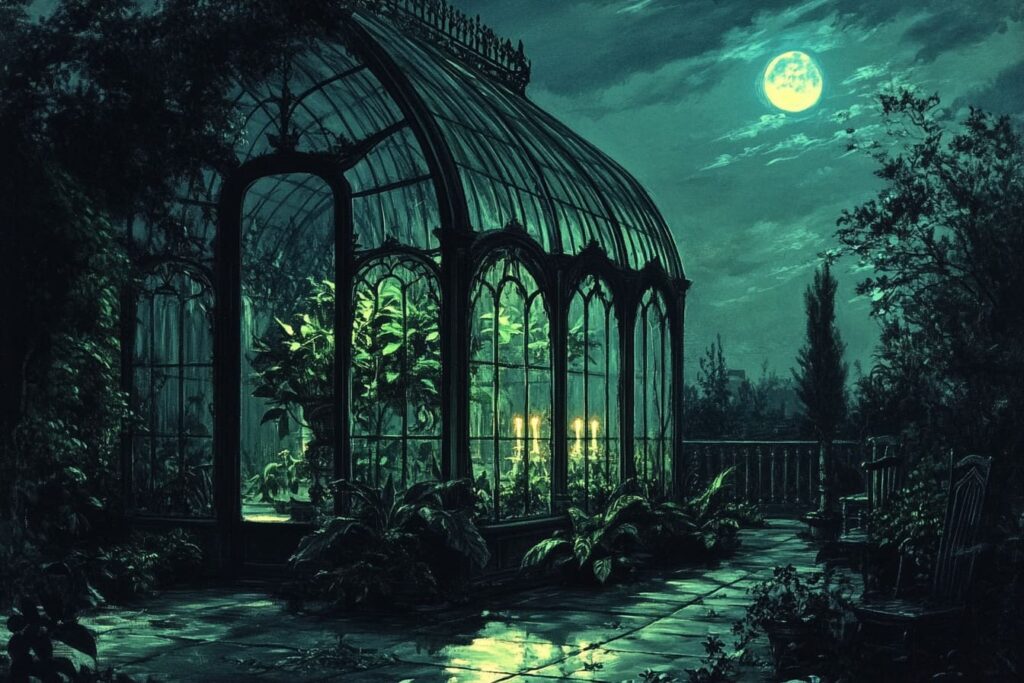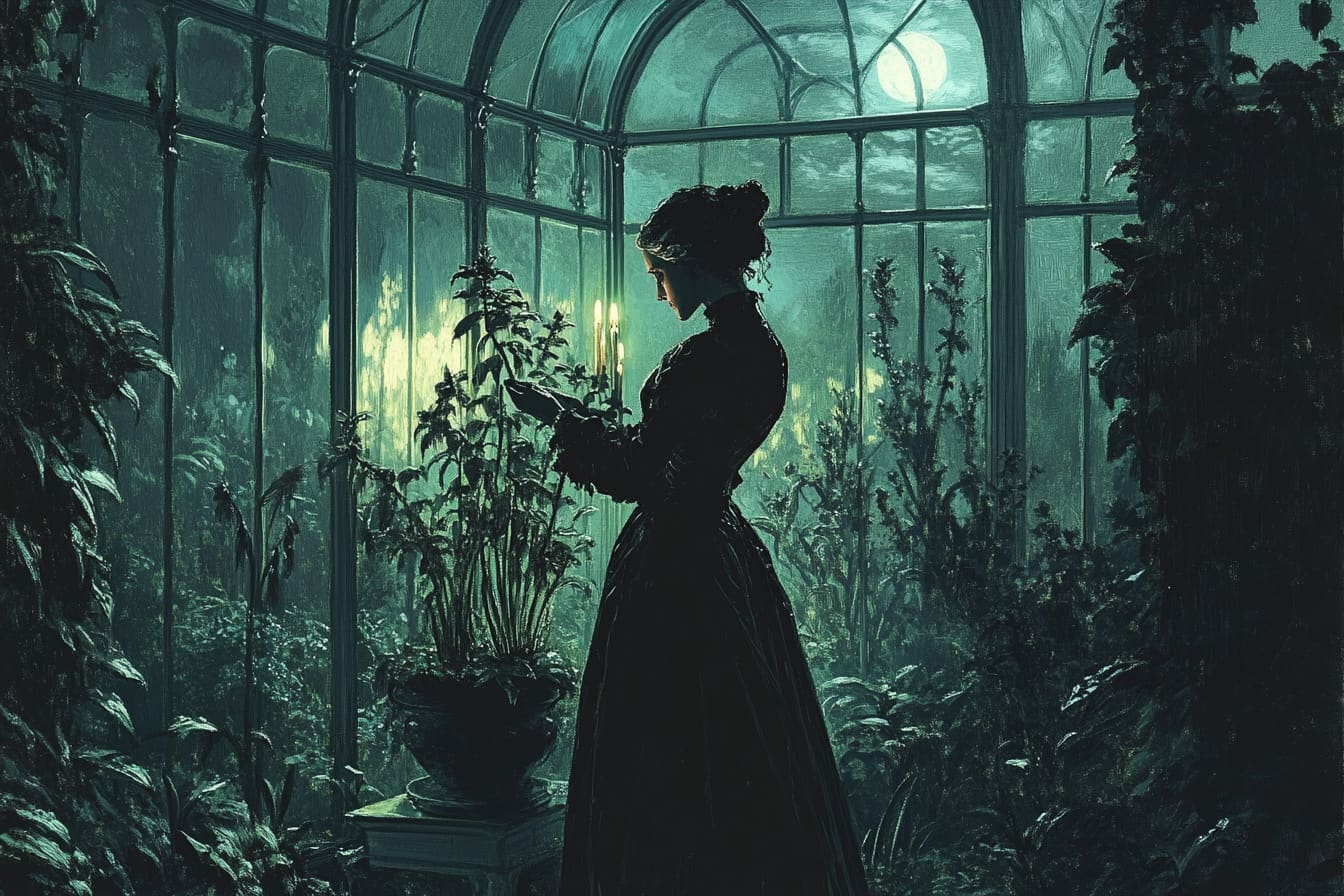Lady Eleanor Blackwood only visited her greenhouse during the full moon, when the lunar energies were at their peak. Tonight, she stood among her collection of rare specimens, her black silk dress rustling against the leaves of towering plants that seemed to lean toward her as she passed.
In one hand, she held a delicate brass candleholder, its flame casting dancing shadows on the glass walls. In the other, she cradled a sprig of night-blooming jasmine, waiting for the exact moment when the moonlight would pierce through the clouds and touch its pearlescent buds.
The greenhouse had been her mother’s legacy—a peculiar inheritance that came with an even more peculiar responsibility. For generations, the women of her family had cultivated plants that existed in the space between the mundane and magical worlds. Each specimen required specific conditions to reveal its true nature: some needed tears of joy, others the whispered secrets of children, and the rarest ones, like tonight’s jasmine, required the precise combination of candlelight and full moon rays.
Eleanor checked her mother’s timepiece. Three minutes until midnight. The jasmine in her palm trembled slightly, as if anticipating what was to come. Around her, the other plants rustled without wind, their leaves shimmering with an otherworldly iridescence that only appeared on nights like these.

The clouds parted right on schedule, and moonlight flooded the greenhouse. Eleanor held the jasmine sprig aloft, allowing both moonlight and candlelight to touch it simultaneously. The buds began to unfurl, but instead of white petals, they released tiny spheres of floating light that hummed a melody she remembered from her childhood—the lullaby her mother used to sing while tending to these very same plants.
Each sphere contained a memory from the plant’s long history: glimpses of other botanists in other times, all of them women in dark dresses, all of them Blackwoods. Eleanor carefully collected the spheres in a crystal vial. These memories were essential for maintaining the greenhouse’s delicate magical ecosystem, and more importantly, for training the next generation of botanical mystics.
As she worked, Eleanor smiled, thinking of her young daughter asleep in the manor house. Soon, it would be time to bring her here during the full moon, to teach her about the secret life of plants that bloomed between worlds. But for now, Eleanor continued her solitary vigil, moving from specimen to specimen, each one requiring its own specific ritual, its own combination of moonlight and candlelight, shadow and illumination.
The night would be long, but Eleanor didn’t mind. In the greenhouse, time moved differently—stretched and bent like the light through its glass panes. Here, among the whispering leaves and luminous blooms, she was not just a botanist but a keeper of ancient secrets, a guardian of the thin places where magic still grew wild and free.
As the moon reached its zenith, Eleanor began to hum her mother’s lullaby, and all around her, the plants hummed back, their leaves trembling with recognition. In the candlelight, her shadow merged with theirs, until it was impossible to tell where the botanist ended and the garden began.
Reader’s Companion: Botanist in a Candlelit Greenhouse
Story Club Discussion Questions
Family Legacy & Inheritance
- How does the greenhouse serve as both a physical and metaphorical inheritance?
- What role do intergenerational relationships play in the story’s narrative?
- Consider how the story treats the passing down of knowledge between women. How might this relate to historical traditions of folk knowledge and healing?
Natural & Supernatural Elements
- Examine the blending of scientific botany with magical elements. How does this intersection reflect broader themes in fantasy literature?
- What significance might the full moon have beyond its practical purpose in the story?
- How does the author use light (moonlight, candlelight) as both a practical tool and a metaphor?
Character & Setting
- What does Eleanor’s solitary nighttime work reveal about her character?
- How does the greenhouse itself function as a character in the story?
- Discuss the significance of the plants’ ability to contain and share memories.
Themes for Further Exploration
The Victorian Language of Flowers
The story draws on the Victorian tradition of floriography, where different plants carried specific meanings. The night-blooming jasmine traditionally symbolizes love, sensuality, and spiritual love, adding another layer to its magical properties in the story.
Women in Botanical Science
The story connects to the real historical tradition of women botanists and natural scientists, many of whom made significant contributions despite limited access to formal education. Consider researching figures like:
- Elizabeth Blackwell (1700-1758)
- Mary Agnes Chase (1869-1963)
- Beatrix Potter (1866-1943)
Gothic Literature Elements
The story incorporates several gothic literature traditions:
- Isolated setting
- Nighttime/moonlight
- Ancient family legacy
- Supernatural elements
- Victorian era aesthetics
Writing Prompts for Further Creative Exploration
- Write a scene from young Eleanor’s perspective, experiencing the greenhouse’s magic for the first time with her mother.
- Compose a detailed description of another magical plant in the greenhouse, including its specific requirements for revealing its powers.
- Create a page from the Blackwood family’s botanical grimoire, describing the proper handling and care of magical specimens.
Recommended Reading
Similar Short Stories
- “The Garden of Live Flowers” from Through the Looking Glass by Lewis Carroll
- “Rappaccini’s Daughter” by Nathaniel Hawthorne
- “The Yellow Wallpaper” by Charlotte Perkins Gilman
Related Novels
- The Night Garden by Polly Horvath
- The Secret Garden by Frances Hodgson Burnett
- Uprooted by Naomi Novik
- The Invisible Life of Addie LaRue by V.E. Schwab
Non-Fiction Connections
- The Victorian Language of Flowers by Margaret Pickston
- Women in the Garden: A History of Women Gardeners by Catherine Horwood
- The Brother Gardeners: Botany, Empire and the Birth of an Obsession by Andrea Wulf
Historical Context
Victorian Conservatories and Greenhouses
The Victorian era saw a boom in greenhouse construction and botanical collection, driven by:
- Advances in glass manufacturing
- Growing middle class
- Interest in exotic specimens
- Colonial expansion
- Scientific advancement
Women’s Roles in Victorian Science
While formal scientific education was largely closed to women, botany was considered an acceptable pursuit, leading to:
- Amateur naturalists
- Scientific illustrators
- Garden designers
- Plant collectors
Writing Exercise: Expanding the World
Consider writing companion pieces that explore:
- The magical properties of other plants in the greenhouse
- The history of the Blackwood family’s botanical discoveries
- A day in the life of Eleanor’s daughter as she begins her magical training
- The origin story of how the Blackwood women first discovered their botanical magic
Questions for Personal Reflection
- What family traditions or knowledge have been passed down in your own family?
- How do you connect with nature in your daily life?
- What role do moments of solitude play in your personal growth?
- How do you preserve and share important memories?
Botanical Terms & Magical Concepts Glossary
- Lunar Energies: The magical properties associated with different moon phases
- Mundane vs. Magical Worlds: The distinction between ordinary reality and supernatural realms
- Memory Spheres: Magical manifestations of stored memories within plants
- Botanical Mystics: Practitioners who blend scientific botany with magical arts
- Thin Places: Areas where the boundary between magical and mundane worlds grows weak
